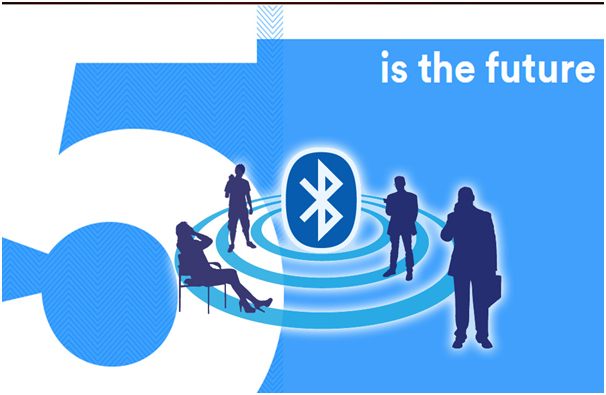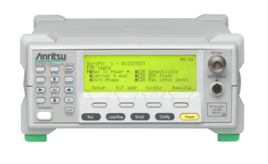With the emergence of the new Bluetooth 5 standard, a number of test companies are emphasizing their ability to support testing for the standard that kicks up BT speed, range and robustness.
 Bluetooth® is the established short-range wireless communications technology for creating a personal area network. Bluetooth® is a frequency hopping spread spectrum system that works in the internationally available ISM bands at 2.4 GHz. Bluetooth® specification 2.0 implemented an enhanced data rate (EDR) of up to 3 Mbit/s. Bluetooth® also follows the trend toward lower power consumption. The Bluetooth® low energy (LE) technology has been adopted in Bluetooth® specification 4.0 to achieve an ultra-low power solution that mainly addresses the Internet of Things (IoT).
Bluetooth® is the established short-range wireless communications technology for creating a personal area network. Bluetooth® is a frequency hopping spread spectrum system that works in the internationally available ISM bands at 2.4 GHz. Bluetooth® specification 2.0 implemented an enhanced data rate (EDR) of up to 3 Mbit/s. Bluetooth® also follows the trend toward lower power consumption. The Bluetooth® low energy (LE) technology has been adopted in Bluetooth® specification 4.0 to achieve an ultra-low power solution that mainly addresses the Internet of Things (IoT).
Bluetooth capabilities are becoming increasingly important for mobile devices, whether in the internet of things space or in traditional mobile devices. Bluetooth testing capabilities have been one major area of development over the past year.
With the emergence of the new Bluetooth 5 standard, a number of test companies are emphasizing their ability to support testing for the standard that kicks up BT speed, range and robustness. Bluetooth 5 devices are hitting the market.

Avichal Kulshrestha, Technical Marketing Engineer at NI explains, “Operating in the ISM band from 2.4 to 2.485 GHz, Bluetooth is a wireless technology standard. Bluetooth is heavily used for communicating or transferring data over short distances. Bluetooth is managed by the Bluetooth Special Interest Group (SIG), which has more than 30,000 member companies in the areas of telecommunication, computing, networking, and consumer electronics. Bluetooth 5, the latest version is a result of continuous evolution of this standard. It heavily focuses on applications such as internet of things with improvements of four times in range, two times in speed and eight times in broadcast signal capacity as compared to its predecessor.”
The following description given by Namita Crystle, Anritsu India. She says, Bluetooth is one of the most successful wireless technologies. It was first developed as an open-standard wireless technology supporting short-range wireless connections between smartphones, PCs, and their accessories. Unlike many other wireless communications systems, it does not require any infrastructure, such as base stations and Wi-Fi access points, and supports efficient voice and data communications between wireless peer-to-peer devices. Bluetooth 5 is the new wireless technology of choice for future smartphone, wireless modules, connected-car, and mainly IoT applications that caters to the evolving market demand of higher data rates, longer range and improved security.”

Asish Jain, Application Engineer, Keysight Technologies India Pvt. Ltd. comments, “Bluetooth 5 is a significant evolution of Bluetooth technology after Bluetooth 4.2 as it makes it go beyond Private Area Network and target wide range of application with improved link budget and data speeds.
This new Bluetooth technology is aimed to cater the requirements of Internet of Things like long range and multi device connectivity. In addition to this, it provides quadrupled data speed improvement up to 2 Mbps over its predecessor.”
Bluetooth and IoT
The latest version of the Bluetooth standard, Bluetooth 5, is set to offer a wide range of enhancements such as longer range, higher speed and extended support for connectionless services. This is a significant upgrade over today’s Bluetooth 4.2 technology, and will open up new IoT applications for the smart environment.
The Internet of Things (IoT) is currently one of the fastest growing technology sectors. Various market analysts predict double digit growth for IoT-enabled devices. Bluetooth technology is set to play a significant part in that growth with its ability to easily connect “things” to host systems. IHS Technology predicts that the number of Bluetooth devices will rise from 2.4 billion in 2014 to 4.4 billion by 2019*. Already, Bluetooth technology is in a very good position for IoT applications. The introduction of Bluetooth 4.2 saw vital additions to the security features and the technological basis for a much higher data throughput – all without compromising energy efficiency.

On the one hand, the realizable radio range of Bluetooth will be increased up to four times, compared to the current generation. This will be achieved by a more elaborate signal encoding. For Bluetooth Low Energy (BLE) Longrange, an unchanged 1 Megasamples/s modulation will be used, but unlike today, two or eight samples will be used for the arrangement of the individual bits (corresponding to 125 kbps / 500 kbps), so that FEC (Forward Error Correction) can be used. Especially in home automation deployments, where multiple walls can be between the communicating devices, or devices can be positioned far apart in the garden, the extended range will enable Bluetooth to be utilized a lot more in its new generation. Another interesting area of application will be smart cities, where high ranges restricted the use of Bluetooth communication until now.
The other vital improvement of Bluetooth version 5 aims at one of the core pain points for Bluetooth technology: increasing the data throughput. Bluetooth 5 defines, in addition to the standard modulation rate of 1 Mbps, another modulation rate of 2 Mbps, resulting in almost twice the maximum data throughput. Not only does this enable devices to transfer bigger data volumes in less time, power consumption is also decreased as a certain amount of data takes less time to be transferred, since power consumption in IoT devices comes mostly down to the time the transmission path is being used. 2 Mbps are mostly a theoretical value, though, with a protocol overhead of around 1.6 Mbps for data transfer in both directions to be expected in practice. Therefore, transmission of data in one direction, for example to a smartphone or tablet, will approximately happen at around 700-800 kbps.
Overall, Bluetooth connections are getting faster as well as more reliable and resilient, making them more and more suitable for the demands on data traffic and security functions in IoT deployments.
In spite of all the changes introduced with Bluetooth 5, devices will still be downward compatible to Bluetooth 4.x devices. Nearly all relevant innovations in Bluetooth 5 are optional for implementation. When implementing Bluetooth 5, device A can have a different feature set than device B. From the outside, that may not be visible as both devices can be qualified for Bluetooth 5. With demands for ever higher data throughputs, though, it is to be expected that most devices will support the abovementioned Bluetooth 5 features.
Bluetooth 6 will further delve into this trend and will deliver new features especially for locating applications.
Telit is already working on a Bluetooth 5 compatible sensor-to-cloud solution. The recently launched Bluetooth Low Energy module “BlueMod+S42” is compliant with the requirements for a later Bluetooth 5 qualification and is primed for mesh applications.
Avichal Kulshrestha, Technical Marketing Engineer at NI shares his views on Bluetooth 5 for IoT ecosystems and explains the testing requirements . He says, “The idea of a smarter world where systems with sensors and local processing are connected to share information is taking hold in every single industry. These systems will be connected on a global scale with users and each other to help users make more informed decisions. Many labels have been given to this overarching idea, but the most ubiquitous is the Internet of Things (IoT). Cisco estimates that by 2022, one trillion devices will be connected in the Internet of Things (IoT). As their number of devices increases, these systems grow not only in size but also in complexity and new challenges for system design. These intricate systems must be networked together to facilitate communication for intelligent decision making. Bluetooth 5’s increase in number of transmissions is very important for IoT as the number of devices connected together is high and increasing. With these higher number of transmissions and improved interoperability and coexistence with other wireless technologies, Bluetooth 5 continues to advance the IoT experience by enabling simple and effortless interactions across the vast range of connected devices.
It is mandatory that any Bluetooth device manufacturer needs to test the device for Bluetooth standard compliance which includes testing the device for various requirements under the standard and testing the device for interoperability with other Bluetooth products. This testing ensures that when these devices hits the market they work seamlessly and completely interoperable with other devices complying to the same standard. This testing enhances product reliability for the end users.”
Asish Jain of Keysight Technologies India mentions, “IoT ecosystem is driven by multiple technologies like NB-IoT, eMTC, Bluetooth, 802.11p/ah, Thread, Zigbee, LoRA, Sigfox etc. to name a few.
Bluetooth 5 is one of the candidate technologies which can be used for IoT applications in home, building and industrial automation.
Imagine Bluetooth 5 chips enabling over the air connections over a km distance for outdoor applications; this makes the new Bluetooth version an integral part of IoT ecosystem.
For indoor applications like home automation, Bluetooth 5 has increased the data broadcasting capacity of transmissions by 8 times over Bluetooth 4.2 which will be important for connecting multiple nodes in a small area.
Test and Measurement companies have to be a step ahead or at least walk hand in hand of the companies working on the new technologies.
It is imperative for T&M companies to provide test platforms which support the new test requirements of upcoming technologies.
Physical layer verification of Bluetooth 5 as per its specifications is an important step in the R&D stage of radio development.
The Bluetooth specifications are developed and licensed by the Bluetooth Special Interest Group (SIG).
This specification is a basis for conformance tests of Bluetooth devices, giving a high probability of air interface inter-operability between different manufacturer’s Bluetooth devices.
Keysight hardware power by latest enhancements in software to support Bluetooth 5 enable R&D and production engineers to validate the performance of this new transmitter and receiver of Bluetooth 5 radio.
Namita Crystle of Anritsu India explains, “The new Bluetooth 5 version offers improved protection against interference with 2.4 GHz ISM bands and the neighbouring LTE band. Since Bluetooth is already implemented in smartphones and tablets, it has an advantage over the other technologies especially in the area of home automation and Infotainment. It also offers longer range, faster speed, lower power consumption and improved security, which are all key functional improvements required for implementing the IoT.
The number of Bluetooth devices reached 3 billion by 2016. In order to support the rapidly evolving IoT environment, Bluetooth SIG has introduced Bluetooth 5 Version. It is focused on implementing longer range communications at faster speeds while maintaining low power consumption to support IoT applications. Market penetration by products using these new functions requires a measurement solution supporting such functions; Anritsu being a measuring instrument maker and a member of the Bluetooth SIG working group since the earliest days, works to develop new measurement solutions for new specifications.”
Keysight Bluetooth 5 Testing Solutions
Keysight’s Next generation of X-series Signal Analyzer with multi-touch Bluetooth measurement application N9081C is used to measure Bluetooth RF transmitter performance, compliant to Bluetooth RF test specifications 2.1+EDR/3.0/3.0+HS and Low Energy (RF-PHY.TS/4.0/4.2/5).
The measurement application is standard-compliant to the Bluetooth Core specification to verify Bluetooth design with confidence and support manufacturing with a single application covering basic rate, EDR and low energy technologies for production.
Similarly, to test physical layer performance of Bluetooth 5 receivers Keysight’s X-series Vector Signal Generators with Signal Studio for Bluetooth signal creation N7606B are used.
This setup provides users a platform to create Keysight validated and performance optimized reference signals compliant to Bluetooth BR (basic rate), EDR (enhanced data rate), LE (low energy) 4.0, LE 4.2 (longer packet length), LE 5.0 (higher data rate and longer range).
New features required for Bluetooth 5 like support for 2Ms/s symbol rate for higher data rate and channel coding for long range are already available with Keysight Signal Studio for Bluetooth signal creation.
Anritsu Bluetooth 5 Testing Solutions
 We currently support Bluetooth 5.0 on 2 solutions, i.e., MT8852B Bluetooth Test Set and MT8870A Universal Wireless Test Set.
We currently support Bluetooth 5.0 on 2 solutions, i.e., MT8852B Bluetooth Test Set and MT8870A Universal Wireless Test Set.
Anritsu Bluetooth Test Set MT8852B is a dedicated measuring instrument for performing Bluetooth RF tests in accordance with the Bluetooth SIG test standards. Along with Bluetooth 5 version it supports the earlier Bluetooth Core 1.2, 2.0, 2.1, 3.0+HS, 4.0, 4.1, and 4.2. versions. With a large range of test items, including RF and connectivity tests for Bluetooth modules and devices, it has wide versatility for every measurement application, from R&D to product inspection and manufacturing.
The MT8870A is a multiplatform set for testing various communications methods, including cellular, connectivity, GPS, FM, etc., on production lines. The MT8870A provides a fast and easy way to measure the Basic Rate , Enhanced Data Rate (EDR), Bluetooth Low Energy, Bluetooth Audio power, frequency, modulation accuracy, Rx sensitivity, etc., parameters required by the Bluetooth test specifications.
NI Bluetooth 5 Testing Solutions
NI’s solutions for Bluetooth testing include a combination of a powerful and flexible PXI platform with a ready to use and Bluetooth measurement suite capable of testing Bluetooth transmitters and receivers with its generation and analysis capabilities. It supports Bluetooth: 1.x, 2.x+EDR, 3.x+HS, 4.2, LE, and the latest Bluetooth 5 LE draft with 2 Mbps data rate. You can either use the ready to run soft front panels for characterization test or use the included comprehensive APIs for LabVIEW and Visual studio for automation needed in production test.






